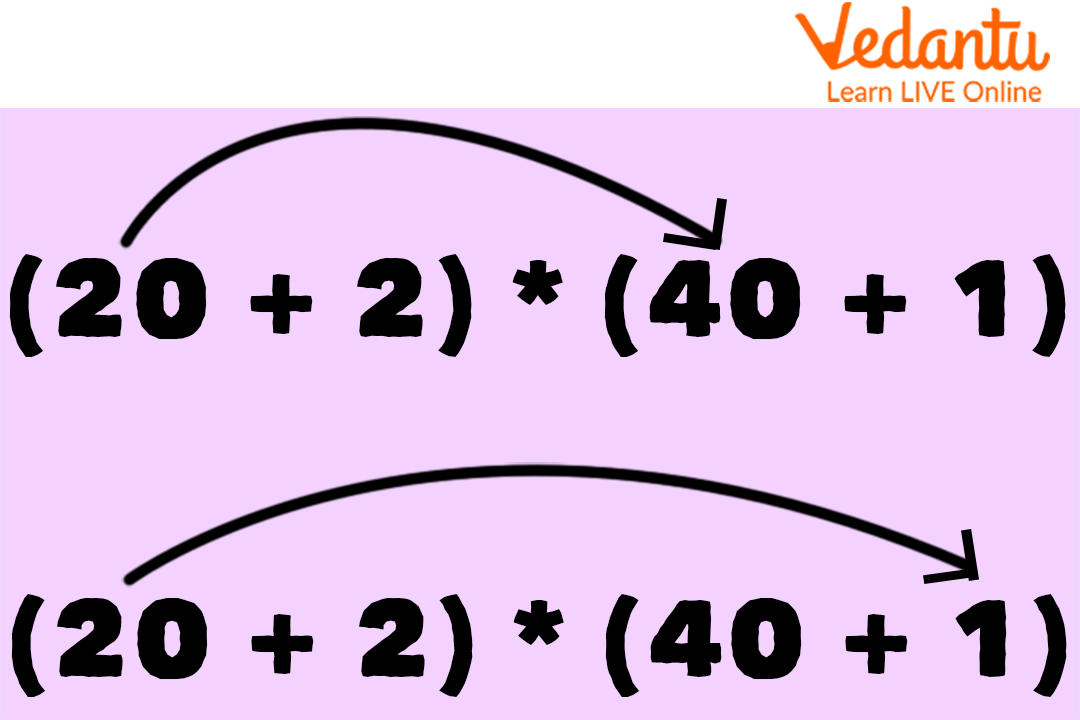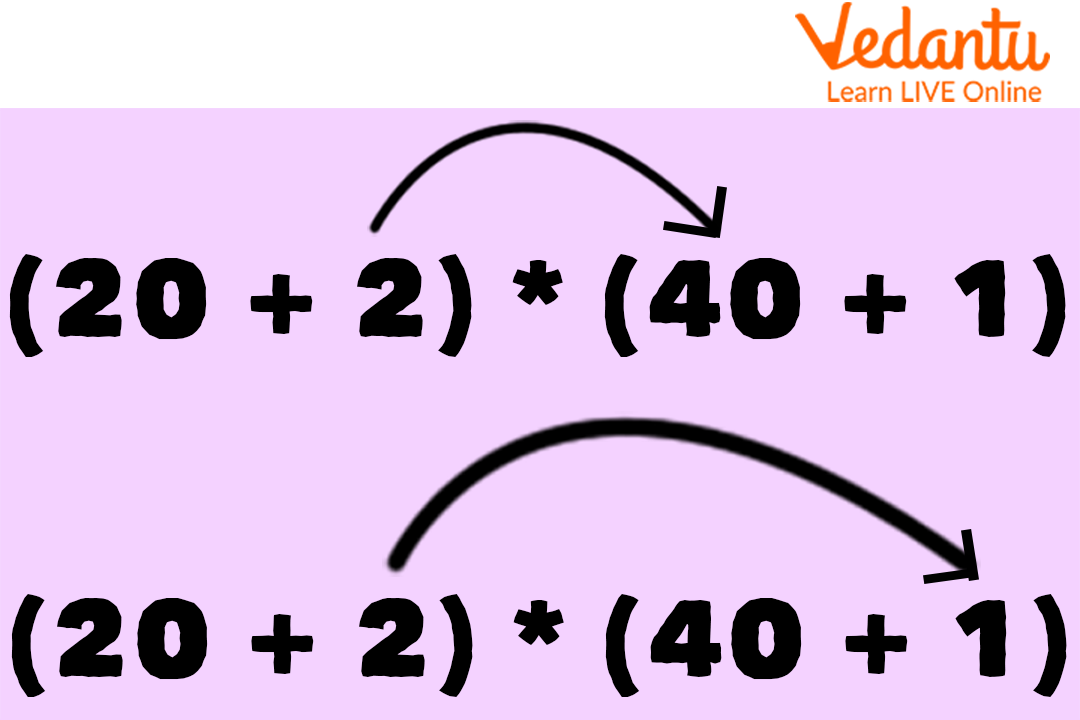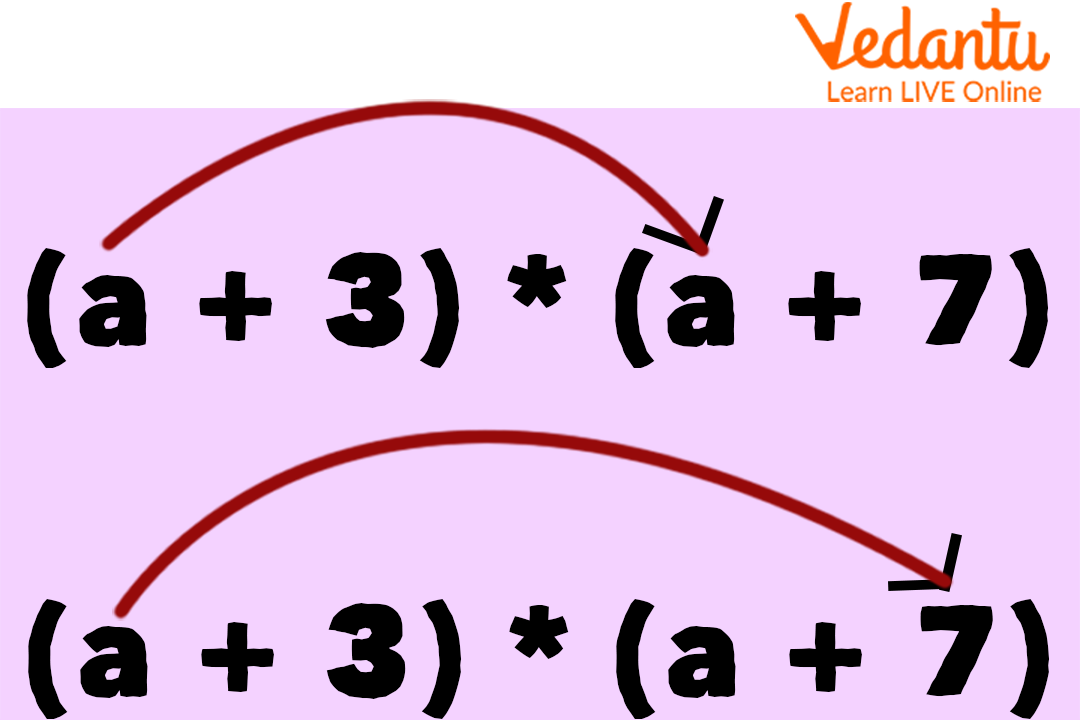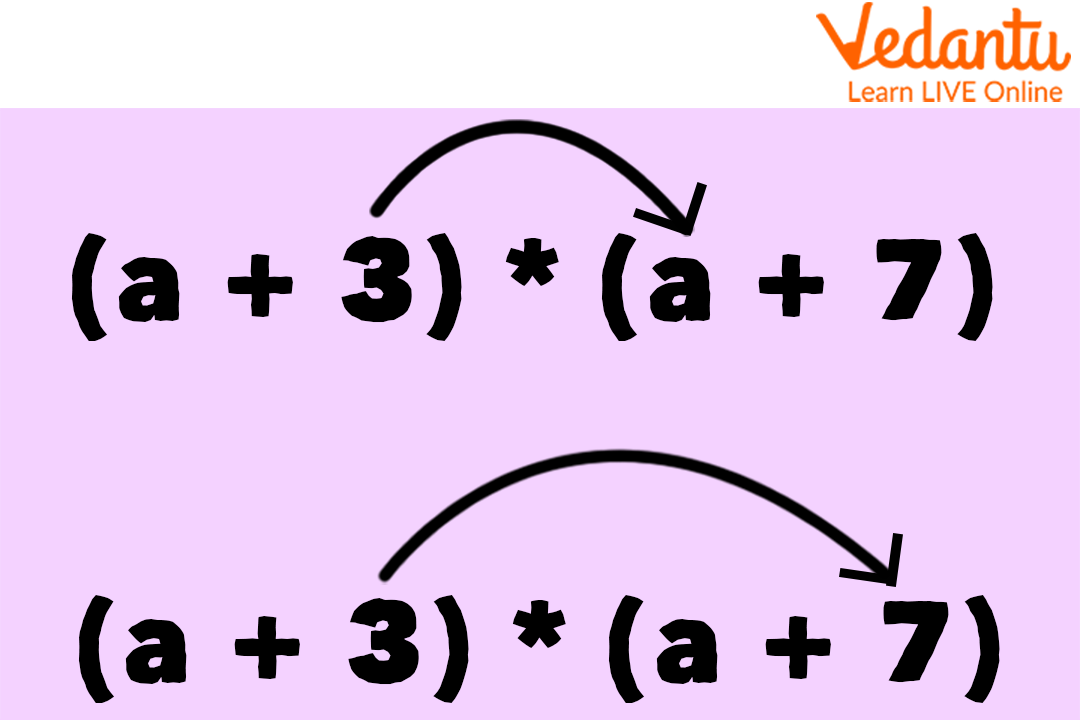




How Does Horizontal Multiplication Work?
Never heard of it? Guess what, you have used it before! Horizontal multiplication is a method we use to multiply numbers and binomials. Have you ever tried multiplying binomials? But couldn’t do it because it was confusing? Well then, you are on the right page, today, we will learn about how to multiply binomials using the horizontal method. Don’t know how to start? No worries, today we will learn about multiplying two-digit numbers first, and then we will learn about binomials. It might be confusing now but by the end of this article, you will be able to use this method easily.
Multiplying Two - Digit Numbers
Let’s start with multiplying two-digit numbers for your understanding.
For example, let’s multiply 22 x 41.
To simplify this, we will write 22 as (20 + 2) and 41 as (40 + 1)
So, now we have: (20 + 2) x (40 + 1)
Looks complicated? Don’t worry, it makes the calculation a lot simpler.
Now, to open the brackets (considering the BODMAS rule, we solve the brackets first), we will multiply the first number (20) of the first bracket by both numbers (40 and 1 separately) of the second bracket.

Multiplication of 2-digit Numbers
Which would be (20 x 40 + 20 x 1) and the result would be (800 + 20) = 820.
Now, we will multiply the second number of the first bracket (2) by both numbers of the second bracket (40 and 1 separately).

Multiplication of 2-digit Numbers
Which would be (2 x 40 + 2 x 1), which would give (80+2) = 82.
Now to get the final solution, we would add both result numbers, which would give: (820+82) = 902.
Let’s do another example without visualization:
Example: 34 x 45
Solution: (30 + 4) x (40 + 5)
= (30 x 40 + 30 x 5) + (4 x 40 + 4 x 5)
= (1200 + 150) + (160 + 20)
= 1350 + 180
= 1530
Note: Look at the signs of addition and subtraction.
What is a Binomial?
It’s a polynomial expression that consists of two terms with either a plus or minus sign in between. It contains a variable, coefficient, exponents, and constant. For example, $(x+5)$, $(y-10)$, etc.
Multiplying Two Binomials
In this section, we are going to learn how to multiply binomials. Now that you have learned how to multiply two-digit numbers, we will move on to binomial multiplication.
Let’s take an example of $(a+3) \times(a+9)$.
Following a similar method to multiplying two-digit numbers, we will first multiply the first variable from the first bracket to both the variable and the number of the second bracket.

Multiplication of 2 Binomials
Which would give us $(a \times a + a \times 7)$ and that would be $\left(a^2+7 a\right)$.
Now, we will multiply the second digit of the first bracket by both the variable and the number of the second bracket.

Multiplication of 2 Binomials
Which would give us (3 x a + 3 x 7) and that would be (3a + 21).
To get the final solution, we will add both results:
(Hint: After solving brackets, we will add the like terms)
$=\left(a^2+7 a\right)+(3 a+21)$
$=\left(a^2+7 a+3 a+21\right)$
$=a^2+10 a+21$
Solved Examples
Now that we have learned the horizontal multiplication method for binomials, we will try to solve a few examples.
Example 1: Multiply (x + 1) (x + 2).
Ans: $(x \times x + x \times 2) + (1\times x + 1 \times 2)$
$=(x^2+2 x)+(x+2)$
$=x^2+3 x+2$
Example 2: Multiply (y + 4) (y - 2).
Ans: $(y \times y - y \times 2) + (4 \times y - 4 \times 2)$
$=\left(y^2-2 y\right)+(4 y-8)$
$=y^2+2 y-8$
Example 3: Multiply (a + 4) (a - 8).
Ans: $(a \times a - a \times 8) + (4 \times a - 4 \times 8)$
$=\left(a^2-8 a\right)+(4 a-32)$
$=a^2-4 a-32$
Example 4: Multiply (y + 6) (y + 9).
Ans: $(y \times y + y \times 9) + (6 \times y + 6 \times 9)$
$=\left(y^2+9 y\right)+(6 y+8)$
$=y^2+9 y+6 y+54$
$=y^2+15 y+54 $.
Example 5: Multiply (x + 2) (x - 2).
Ans: $(x\times x - x \times 2) + (2 \times x - 2 \times 2)$
$=\left(x^2-2 x\right)+(2 x-4)$
$=x^2-2 x+2 x-4$
$=x^2-4$
Can you do it too?
Now that we have solved a few examples, let’s see if you can solve some on your own too.
Q 1: Multiply (a + 1) (a - 2).
Ans: $a^2-a-2$
Q 2: Multiply $(y+7)(y-8)$.
Ans: $y^2-y-56$
Q 3: Multiply $(5+x)(x-2)$.
Ans: $x^2+3 x-10$
Q 4: Multiply $(8+y)(y+7)$.
Ans: $y^2+15 y+56$
Q 5: Multiply $(a+5)(a-9)$.
Ans: $a^2-4 a-45$
Summary
The horizontal method is a multiplication method, which is done by arranging the variables and numbers in a horizontal line and then multiplying them step by step, making the calculation easier. First of all, we learned that we need to write the values in a horizontal line, and arrange the question in a way that all like terms are together. Then we saw that we had to apply the BODMAS rule and multiply both values of the first bracket with both values of the second bracket separately. In the end, just combine the result. And there we go, we got the result. To understand these steps more clearly we have added the practice problem too, so after going through this article give it a try!
FAQs on Horizontal Multiplication Explained
1. What is the horizontal method of multiplication?
Horizontal multiplication is a method where numbers are written side-by-side and multiplied, often by breaking one number into its place values (like tens and ones). For example, to multiply 23 by 5, you would write it as 23 x 5. You would then break 23 into (20 + 3), multiply each part by 5, and add the results: (20 × 5) + (3 × 5) = 100 + 15 = 115.
2. How do you multiply a 2-digit number by a 1-digit number using the horizontal method?
To multiply a 2-digit number by a 1-digit number horizontally, follow these steps. Let's use the example 45 x 3:
- Step 1: Write the problem horizontally: 45 x 3.
- Step 2: Break the 2-digit number into its expanded form based on place value: (40 + 5).
- Step 3: Multiply each part by the 1-digit number: (40 x 3) and (5 x 3).
- Step 4: Calculate the products: 120 and 15.
- Step 5: Add the results together to get the final answer: 120 + 15 = 135.
3. What is the main difference between horizontal and vertical multiplication?
The main difference lies in the arrangement and process. In horizontal multiplication, numbers are written side-by-side (e.g., 52 x 4) and solved by breaking numbers into place values. In vertical multiplication, numbers are stacked on top of each other, and you multiply digits in columns, carrying over values, which is often more organized for larger numbers.
4. When is it better to use the horizontal multiplication method?
The horizontal multiplication method is particularly useful in a few scenarios:
- When performing mental math, as it's easier to break down numbers and calculate in your head.
- For multiplying numbers that are easy to break apart, like multiplying by 10 or 100.
- When teaching the concept of the distributive property, as this method visually demonstrates it.
- For simpler calculations, such as a 2-digit number by a 1-digit number, as it can be faster than setting up a vertical problem.
5. How does place value play a crucial role in horizontal multiplication?
Place value is the foundation of the horizontal multiplication method. The method works by deconstructing a number into its constituent parts based on place value (e.g., the '5' in 54 is actually 50, and the '4' is 4). By multiplying each part separately (e.g., 50 x 2 and 4 x 2) and then adding them, you ensure that you are accurately multiplying the tens, ones, and so on, without losing track of their true value. It reinforces the understanding that multiplication is distributed across these values.
6. Can you explain how to multiply two 2-digit numbers horizontally, for example, 24 x 31?
Yes, this uses the same principle. You break both numbers into their place values. For 24 x 31:
- Step 1: Write the numbers in expanded form: (20 + 4) x (30 + 1).
- Step 2: Use the distributive property to multiply each part of the first number by each part of the second number. This involves four separate multiplications:
- (20 x 30) = 600
- (20 x 1) = 20
- (4 x 30) = 120
- (4 x 1) = 4
- Step 3: Add all the products together: 600 + 20 + 120 + 4 = 744. This method ensures every part of each number is multiplied correctly.
7. Is horizontal multiplication related to any important mathematical properties?
Yes, horizontal multiplication is a direct application of the Distributive Property of Multiplication over Addition. This property states that multiplying a number by a sum is the same as multiplying the number by each addend separately and then adding the products. For instance, in 6 x (10 + 2), the horizontal method calculates (6 x 10) + (6 x 2), which is the textbook definition of the distributive property in action.















